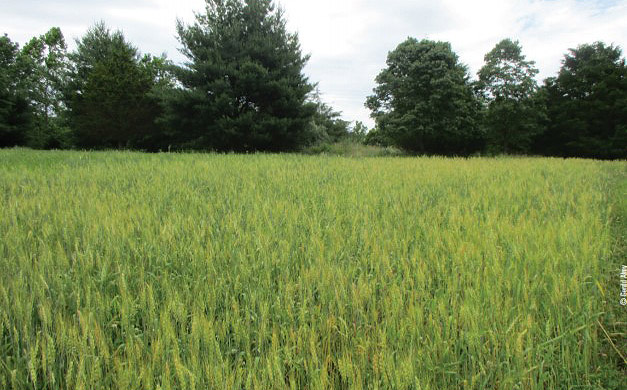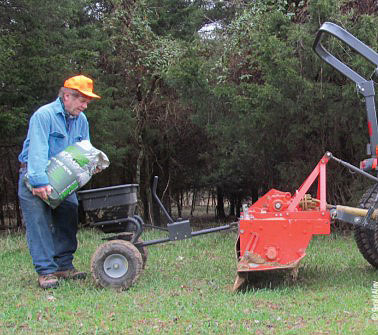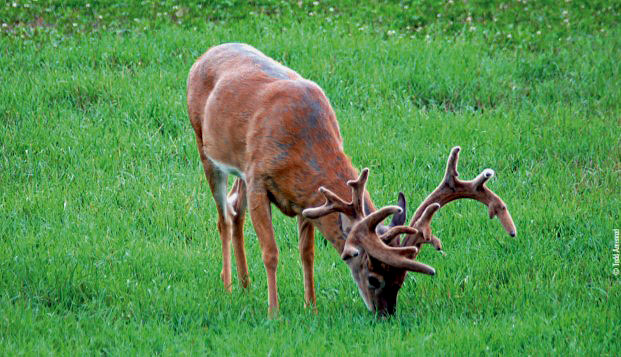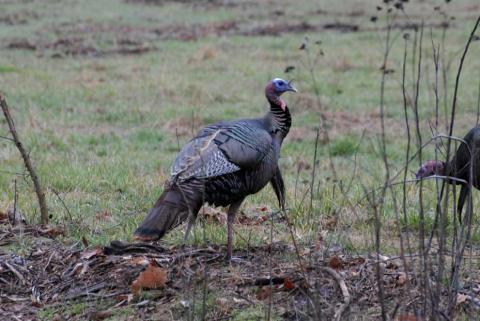Gerald Almy | Originally published in GameKeepers: Farming for Wildlife Magazine. To subscribe, click here.

The world of food-plotting has seen a number of new cultivars come to market in recent years, some touted as “magic,” or “irresistible to whitetails.” With these new varieties on the market, some in wildlife management may scoff at such plain “golden oldie” forages as wheat, oats, and rye. Heck, that’s what our grandfathers used!
A “millennial food plot farmer” may say, “Surely we can do better than that.” We want the latest strain of clover, the biggest-leaved brassica, a crossbred soybean that can grow eight feet tall - to heck with that old-fashioned stuff. Cereal grains just “don’t get any respect.” They’re old school plants for old fogeys.
Well I guess I’m an old fogey. Having started growing food plots way back in the 1980’s, I cut my teeth on planting cereal grains. And when I went to hunting lodges seeking stories for my employer back then, “Sports Afield,” that was what most of the habitat managers for the properties were growing. I have to say the deer on those properties looked pretty darn good. And they sure ate lots of those cereal grains.
Then came clovers, brassicas, forage soybeans, and on and on from there. New products seem to be unveiled every year that are said to be designed to attract better or provide improved nutrition. I even saw one garden flower that’s now being sold as deer food plot forage.
Well folks, been there, done that. I’ve experimented with almost all the newest food plot rages. It’s my job, but I’d do it even if it wasn’t. The truth is; it’s still hard to beat old-fashioned cereal grains for a late summer, fall, early winter, and in some areas, early spring food plot.

Here we see the author loading Winter Grass Plus for
planting. A blend of several cereals, and possibly other
plants like brassicas or clovers, can dramatically extend
the palatability timeframe over a single cultivar.
If you look at the qualities that food plot forages should have, cereal grains come out surprisingly well compared to the other varieties available, such as perennial clovers, brassicas, and warm season annuals. To my mind, the factors a good plant should have include high protein content, palatability, digestibility, resistance to over-browsing, forage available for a long period, ease of growing, low cost, drought hardiness, and adaptability to a variety of soils.
Cereal grains do well in most of these areas. So don’t be so quick to write off these humble, inexpensive cultivars. They did the job for generations of early food plotters. And they’re still contributing to most knowledgeable gamekeepers’ wildlife management plans today in 2019, both as mono-cultures, and mixed with other forages.
Benefits of Cereal Grains
Four cereal grains can be useful for food plotters—rye, oats, wheat, and triticale. Before getting into the specifics of each, what type of soils they like, and how to integrate them into your land management plan, let’s look at some of the benefits of these plants, many of which have been around since before Christ.
First off, they all have high levels of carbohydrates and are great source of energy. That’s vital for deer heading into the rigors of the rut and the stress of winter. They are also highly digestible to a whitetails four-chambered stomach. In addition, they are easy to grow and inexpensive. Whitetails love the taste of all of them, and they can withstand fairly heavy feeding pressure.
Cereal grains are good for the soil in a variety of ways. Planting them prevents erosion and reduces moisture loss. Grains can scavenge nitrogen and also drill through and aerate the soil, reducing compaction. They suppress weeds and provide good choices for crop rotation after legumes are grown, utilizing the extra nitrogen. Several of them suppress harmful nematodes and all create valuable organic matter. Finally, if the deer don’t demolish them, they can be grazed by livestock or produce grain or hay.
Cereal grains can be drilled, broadcast, over-seeded, or no-till planted. When planted with other crops such as brassicas, annual clovers, or perennials, they can take the early feeding pressure off those plants, helping to protect them during their vulnerable early growth stages and acting as a “nurse crop.” This is particularly important for brassicas for two reasons. It allows them to obtain some growth so they can get tall enough to be accessible to deer through the snow later in winter so it allows them to grow until cold turns their starches into sugars. Whitetails will be drawn to the plots by the grains, then switch to the brassicas as they become both larger and sweeter.
These forages are superb at drawing deer out of thick cover during early fall, when most native plants have low palatability and are often drying up and turning brown. While oats may not last through the coldest winters, some cereals such as wheat and rye will survive in more temperate zones and usually come on with a flush of lush, new growth during late winter and early spring. This period is especially important and the cereals can act as a forage “bridge” for whitetails, between the brassicas they use during winter and perennials, such as white clover and alfalfa that begin producing growth in March or April.

If they start to grow too tall and become unpalatable, they can be mowed to create new, tenderer growth. In southern areas when properly managed grains can provide forage from September through spring.
In the North some may die out in winter or become unreachable under deep snows, but still provide fall, early winter and sometimes spring forage as well. Some varieties can even be planted in spring in northern areas, to provide a quick crop in early summer before they become too tall and tough. Most gamekeepers, though, prefer to put oats and wheat in during late summer.
Cereal grains are easy to establish. I’ve seen them emerge in just a few days and draw feeding deer within two weeks. This not only helps other cultivars you’re trying to establish, it takes pressure off native browse and allows you to carry a larger population of deer.
Different varieties of cereal grains can grow in both wet soil areas (rye and wheat) and dry uplands (oats and triticale). There is almost always a good choice for your different soil types and soil qualities. If your dirt is higher quality, opt for wheat or oats. Go with rye in acidic, shaded, low fertility, or sandy soils. Triticale can work in either situation but does better in higher quality soils.
Most Popular Cereals Planted for Whitetails
Rye (Secale cereale)
This cool season annual was first brought to our country by the English and Dutch settlers to make flour for bread. This is a great choice for novice food-plotters because it’s so easy to grow. Just prepare a smooth, weed-free plot, scatter seed, and disk it in ¼ to ½ inch and voila! A great field of rye will emerge. Just be sure you’re planting “cereal rye,” not “rye grass!”
Rye tolerates drought conditions well and is very coldhearty. It will overwinter in most regions and can actually sometimes become a weed problem, reemerging on its own if left to go to seed.
Rye is one of the cheapest cereal grains you can buy. It’s only a small part of most Mossy Oak products because it isn’t as high in nutritional quality as other cereals. But it is a component in some of them such as Hot Spot because it tolerates shade, establishes quickly and grows well in acidic soils, typical of most deep woods food plots.
Forage production ranges up to 7,000 pounds per acre. Rye can grow to five feet tall, though it’s most useful for attracting deer when it’s in the 2-6 inch range. Deer do not consume the seed heads, so there’s no benefit to allowing rye to mature. Mow it down when deer stop feeding on it and incorporate it into the soil as organic material. It’s not the best choice as a nurse crop for perennial clovers because it grows so tall. Instead, go with oats or wheat for that job.

nurse crop with clover, as shown here. As the
grain dies out, the clover comes on strong.
Rye protein levels are modest at 9-15 percent, but can range to over 20 percent. My experience has been that deer will consume all three other major cereal grains more readily, but if rye is what’s there, they’ll eat it. Mixing with annual clovers improves the plot’s palatability, and the legumes provide nitrogen that increases the rye growth and health. Add 50-75 pounds per acre of nitrogen a few weeks after the plant emerges.
Wheat (Triticum aestivum)
Before I began using blends from companies such as Mossy Oak, wheat from the local farm cooperative was my go-to fall cereal grain crop. It seemed a bit easier to grow than oats, heartier in cold weather and less drought-susceptible. It tolerated wet soils and was cheap - important back then and still today! Most importantly, deer love it.
Wheat thrives in a more neutral pH soil than rye, but you don’t need the pH as high as you would for clovers or alfalfa. A 6.0 reading or better is fine. Only minimal lime may be required to reach that. Or if you’re lucky like me, your soil is already above that. Somewhat wet or shady areas are okay for wheat.
Protein can range up to 25 percent, with acid detergent fiber (ADF) levels in the 20-25 percent range, similar to oats. It can yield up to 5,000 pounds dry weight forage per acre. Wheat mixes well with brassicas, winter peas, and annual clovers like crimson and arrowleaf.
Plant wheat just like you would rye, about ¼ to ½ inch deep. Even scattered seeds on top will usually germinate, but not as consistently as when covered lightly. Cultipacking helps but isn’t vital. It can be planted as early as July in the North and as late as November in the South.
Fertilize as your soil test dictates or use a 20-20-20 or similar balanced NPK mix. Almost all cereal grains, including wheat, can benefit from adding urea (N) such as 46-0-0 or similar a month or two after planting or if the leaves look pale and yellowish instead of deep green.
If you don’t have enough deer to keep the crop down, mow it when it grows taller than six to eight inches. Then fresh new shoots will emerge and whitetails should flock to it. Among Mossy Oak products my favorites that incorporate wheat include Full Draw, Outfitters Blend, and Winter Grass Plus. If you plan to allow some of your wheat crop to go to seed in late spring, consider choosing an awnless variety. Studies at the University of Tennessee have shown that deer exhibit a strong preference for these varieties without the sharp, protruding “awns.”
If you’ve ever looked at these stiff, sharp “needles” protruding from the seed head, you’ll understand why they don’t like them. They will eat some seed heads of this type, just not as eagerly. Leaving some wheat to go to seed is also a great move for turkeys, which will feed heavily on the seeds. Wheat seeds can provide as much energy and carbohydrates as corn, and more protein, at 12 percent.
Oats (Avena sativa)

are all very versatile, hardy, and easy to plant
food plot crops. They work well when mixed
with legumes (both annual and perennial),
brassicas or other cereals.
These plants originated in Turkey, Iraq, and Europe. They can grow over three feet tall, but like the others, deer prefer them from about 3-6 inches. After that they’ll need to be grazed or mowed down to stay palatable unless you have enough deer to keep them at the optimum height for palatability and nutritional content. Oats are often deeper green in color than other grains. To keep this rich color and high nutrient content, add urea (N) at about 50 pounds per acre 3-6 weeks after planting or if the leaves start to turn yellowish or pale green.
Protein content is excellent, in the 18-25 percent range, but oats don’t do well in excessive heat or wet areas. Oats may be the most favored cereal grain of all as far as taste (attraction), with wheat a close second. Acid detergent fiber, or ADF (the indigestible portion of the plant), often measures below 20-25 percent, which is superb. Oats are great for nurse crops with perennial clovers, mixed with brassicas or other cereal grains, or planted alone. They can produce up to two tons per acre of forage and thrive under heavy browsing pressure.
Oats planted during late summer or fall can provide a strong flush of growth and attract deer for several months in northern regions, but often it won’t survive the winter. You can also plant for the spring in these regions and get a late spring early summer crop. Mossy Oak’s Trophy Oats include both early-maturing and cold-tolerant species in their mix so they can produce from August through winter.
Triticale (Triticosecale) This plant is a cross between wheat (TRITicum) and rye (SeCALE). Several scientists were working on similar projects and developed this new forage in labs in Sweden and Scotland around 1875. It is higher in protein content than wheat, and combines the yield potential and high digestibility of wheat with the disease resistance and cold-tolerance of rye. It’s a good substitute if you wanted to grow wheat but the soil pH is too acidic.
I’ve found deer relish this cereal grain and it is extremely palatable to them when mixed with crimson clover. The clover also extends the life of the plot during late spring when the triticale gets too tall and tough to be attractive. This seed is found in several Mossy Oak fall mixtures.
Triticale has awns, so it is not a good idea to let it go to seed, as deer do not like feeding on the seed heads with these sharp structures attached.
These cereal grains may not be “exciting” food plot forages, but deer love them, they are nutritious and beneficial to their health, and should be a “building block” in your “food plot wall.” As a bonus, few things are more uplifting on a cold, gray winter day than looking out on a shimmering green wheat or oat field. These cultivars should definitely be a part of any gamekeeper’s wildlife management program.
Final Tip:
One of the most common mistakes food plotters make with cereal grains is to plant them too sparsely. It takes A LOT of seed to grow a really thick, lush plot that will allow deer to get a mouthful of food with each bite instead of two or three thin leaves. Heavier planting rates means each plant will be smaller with less stem and thus more palatable. It took me years to learn this lesson, now I always err on the heavy side of recommended seeding rates when it comes to cereals.































